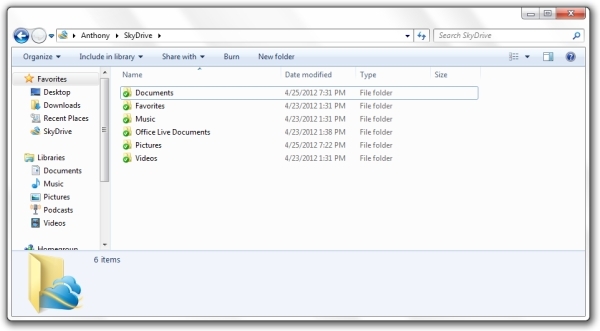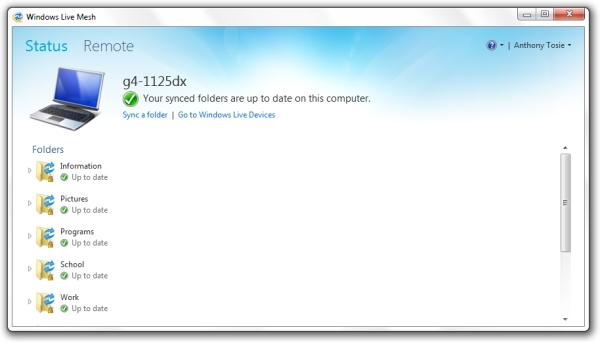With cloud-based storage services suddenly in vogue, it's no surprise that Microsoft and Google launched their cloud storage services ? SkyDrive and Google Drive, respectively ? only a day apart from one another. Clearly neither company wants the other to gain valuable momentum. So why then is Microsoft not using its secret weapon, Windows Live Mesh, to put SkyDrive head-and-shoulders above the competition?
It also shouldn't come as any surprise that Microsoft still hasn't decided exactly what it wants to do in the cloud storage industry, given that the company's cloud storage history is tumultuous at best. For those who are unaware: Microsoft's first legitimate foray into the realm of cloud storage was FolderShare, which it purchased in 2005 and later rebranded Windows Live Sync in 2008. At the same time, the company was preparing the Windows Live Mesh technology preview. It took Microsoft another two years before it combined the two services.

So here we are, again in the same scenario: Microsoft has two competing cloud-based storage services, except this time the two services are actually fairly different. SkyDrive is the more "typical" of the two services ? a specially-branded folder is placed in a user's account; the user can then save or move files to the folder to sync files with SkyDrive's servers. This is the same style of service offered by Microsoft's competitors: Google Drive, Dropbox, and most other cloud storage services have a similar management system.
Windows Live Mesh has a different approach to cloud storage. With Mesh, users can select specific folders to sync with Microsoft's SkyDrive servers. Users don't have to place files or folders in a specific place; instead, the program will recognize where folders are located and sync them across platforms. Users can select specific folders to sync, regardless of their location. While a few other services offer this capability ? most notably SugarSync ? the majority don't, SkyDrive included.

Currently, I have both SkyDrive and Windows Live Mesh installed. "Well, that's just stupid!" you might argue. I'd argue it's out of a desire to keep my files backed up without worry. While SkyDrive's great if you're collaborating for specific projects, it's much easier to simply have Mesh sync my important folders. When my last laptop decided life wasn't worth living anymore, all my important documents were already synced to my desktop, which made my life much easier. I didn't have to worry about whether or not I had moved my files to the specific syncing folder?? it all just worked.?
That's not to say SkyDrive doesn't have its uses. The service is fantastic for working on projects with others or sharing a specific set of files. Sharing photographs between devices is also great. Additionally, SkyDrive began offering tiered space levels for purchase with its relaunch earlier this week, a service option which isn't currently available in Windows Live Mesh. What would make these tiered levels more enticing, however, would be the option to use them with Windows Live Mesh features. More content could be synced in the background, and users wouldn't have to micromanage their files to a specific folder.
From a consumer perspective, I think Windows Live Mesh is currently the more compelling option. If consumers were given the ability to purchase tiered storage levels as they are on SkyDrive, it could prove to be a hit. Businesses likely don't require the same features, however, and sharing a SkyDrive folder may be more than enough for them. But SkyDrive doesn't appear to be marketed at businesses at the moment; in fact, Microsoft's recent discussions of the service have seemed to target consumers. When the company's displayed the deep integration the service will have in Windows 8, for instance, it's primarily showed this through a consumer's viewpoint. If the service is going to cater to consumers, or cater to both consumers and businesses, then it'd make sense to include the intelligent folder syncing capabilities of Mesh.
So, why is Microsoft not combining the two services? I mean, it's no secret that the Windows Live software suite isn't going to be around for much longer. And Mesh already uses the SkyDrive servers for its intelligent folder syncing. It's simply perplexing that Microsoft didn't relaunch SkyDrive earlier this week with Windows Live Mesh's capabilities in tow. It's time to merge SkyDrive and Windows Live Mesh, Microsoft. If you want to be the penultimate cloud-based storage service, you need to have all your best features under one brand.
dumpster seattle business for sale utility truck caps chimney caps chapel hill
কোন মন্তব্য নেই:
একটি মন্তব্য পোস্ট করুন